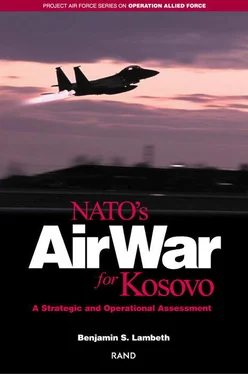Still another disappointment centered on what turned out to be NATO’s almost completely ineffective efforts to engage mobile enemy troops operating in Kosovo. That disappointment underscored the limits of conducting air strikes against dispersed enemy forces hiding in favorable terrain in the absence of a supporting allied ground threat. Had Serb commanders any reason to fear a NATO ground invasion, they would have had little alternative but to position their tanks to cut off roads and other avenues of attack, thus making their forces more easily targetable by NATO air power. Instead, having dispersed and hidden their tanks and armored personnel carriers, Serb army and paramilitary units were free to go in with just a few troops in a single vehicle to terrorize a village in connection with their ethnic cleansing campaign.
Senior civilian defense officials and U.S. Air Force leaders freely conceded after the Serbian withdrawal that the problems encountered by the largely failed effort against fielded enemy forces reflected real challenges for the effective application of air power posed by such impediments as trees, mountains, poor weather, and an enemy ground force that is permitted the luxury of dispersing and hiding rather than concentrating to maneuver to accomplish its mission. Yet while it was essential for NATO to try its best to keep Serb forces pinned down and incapable of operating at will, the majority of the sorties devoted to finding and attacking enemy troops in Kosovo entailed an inefficient and ineffective use of munitions and other valuable assets. That said, the targeting of enemy ground forces operating within Kosovo was an inescapable political necessity, considering that those forces were responsible for committing the ethnic cleansing acts that NATO had vowed to stop. Failure to target those forces would almost certainly have caused the bombing effort to lose credibility in the eyes of the NATO civilian leadership.
Pressures to avoid civilian casualties and unintended damage to nonmilitary structures were greater in Allied Force than in any previous combat operation involving U.S. forces. Nevertheless, there were recurrent instances throughout the air war of unintended damage caused either by errant NATO munitions or by mistakes in targeting, including a dozen highly publicized incidents in which civilians were accidentally killed. One such bombing error resulted in part from constraints imposed by the requirement that NATO aircrews remain above 15,000 ft to avoid the most lethal enemy threats, making visual discrimination between military and civilian traffic more than routinely difficult. Another contributing factor was the occasional tendency of allied aircrews to maneuver their aircraft in such a way as to put clouds within the targeting pod’s field of view between the aircraft and the target, thus blocking the laser beam illuminating the target and depriving the weapon of guidance. Moreover, Serb forces often used civilians as human shields in an effort to deter NATO from attacking military vehicles. The extraordinary media attention given to these events bore ample witness to what can happen when zero noncombatant casualties becomes not only a goal of strategy but also the international expectation. Thanks to unrealistic efforts to treat the normal friction of war as avoidable human error, every occurrence of unintended collateral damage became overinflated as front-page news and treated as a blemish on air power’s presumed ability to be consistently precise.
LAPSES IN STRATEGY AND IMPLEMENTATION
NATO’s leaders also had little to congratulate themselves about when it came to the way in which the air war was planned and carried out. There was a dominant sense among participants and observers alike that the desultory onset of Allied Force and its later slowness to register effects reflected some fundamental failures of allied leadership and strategy choice. In contrast to the relatively seamless performance by the coalition in Desert Storm, what unfolded during NATO’s air war for Kosovo was a highly dissatisfying application of air power, which showed not only the predictable fits and starts of trying to prosecute an air operation through an alliance of 19 members bound by a unanimity rule, but also some failures even within the operation’s U.S. component to make the most of what air power had to offer within the limits of the effort’s political constraints.
To begin with, the conduct of the air war as an allied effort came at the cost of a flawed strategy that was further hobbled by the manifold inefficiencies that were part and parcel of conducting combat operations by consensus. In addition to the natural friction created by NATO’s approach to target approval, the initial reluctance of its political leaders to countenance a more aggressive air campaign in terms of target numbers and force size failed completely to capitalize on air power’s potential for taking down entire systems of enemy capability simultaneously. Further compounding the inefficiency of this multistage and circuitous process, two parallel but separate mechanisms for mission planning and air tasking were used. Any U.S.-specific systems involving special sensitivities, such as the B-2, F-117, and cruise missiles, were allocated by U.S. European Command (USEUCOM) rather than by NATO, and the Combined Air Operations Center (CAOC) maintained separate targeting teams for USEUCOM and NATO strike planning.
Because NATO had initially hoped that the operation would last only a few days, it failed to establish a smoothly running mechanism for target development and review until late April. Once NATO’s going-in assumption proved hollow, a frenetic rush ensued to come up with additional target nominations that could be more quickly and easily approved by NATO’s political authorities. Even then, there was little by way of a consistently applied strategy behind the target development process. Most of the attack planning done throughout the air war was not driven by desired effects, but rather entailed simply parceling out sortie and munitions allocations by target category as individual targets were approved, without much consideration given to how a target’s neutralization might contribute toward advancing the overall objectives of the air war.
It was not only the alliance-induced friction that helped make for an inefficient bombing effort. As Allied Force unfolded, it became increasingly clear that even the U.S. military component was divided in a high-level struggle over the most appropriate targeting strategy—reminiscent of the feuding that had occurred nine years earlier between the Army’s corps commanders and the joint force air component commander (JFACC), then–Lieutenant General Charles Horner, over the ownership and control of air operations in Desert Storm. Once the initial hope that Milosevic would fold within a few days after the bombing started proved groundless, NATO was forced into a scramble to develop an alternative strategy. The immediate result was an internecine battle between the Supreme Allied Commander in Europe, U.S. Army General Wesley Clark, and his air component commander, USAF Lieutenant General Michael Short, over where the air attacks should be primarily directed. Short maintained that the most effective use of allied air power would be to pay little heed to dispersed Serbian forces in Kosovo and to concentrate instead on infrastructure targets in and around Belgrade, including key electrical power plants and government ministries. However, Clark insisted, as was his command prerogative, upon concentrating on elusive enemy ground troops in Kosovo, and this targeting emphasis prevailed throughout most of the air war.
Despite the success of Allied Force in the end, one misjudgment of near-blunder proportions came close to saddling the United States and NATO with a costly and embarrassing failure. The worst call by NATO’s leaders was their assumption that what had worked for Bosnia would work for Kosovo and their resultant failure to appreciate the special importance of Kosovo to the Serbs and its criticality to Milosevic’s survival in power. Fortunately for the allies, their faulty assessment was not a show-stopper—although it could have been if Milosevic had refrained from launching his ethnic cleansing campaign and instead merely hunkered down to wait out the bombing in a win-or-lose contest of wills with NATO. Had he done so, he could have threatened the long-term viability of the alliance. Fortunately for the success of Allied Force, by opting instead to accelerate his ethnic cleansing of Kosovo, he helped unite Western opinion behind NATO and left NATO with no choice but to dig in for the long haul, not only to secure an outcome that would allow for the repatriation of nearly a million displaced Kosovars, but also to ensure its continued credibility as an alliance.
Читать дальше












